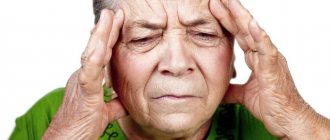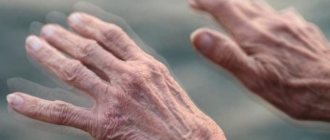General information
Fainting is also called syncope (this word comes from the Latin word syncope, which, in fact, is translated as “fainting”). The definition of fainting is as follows: it is an attack of loss of consciousness for a short time, associated with temporarily disrupted cerebral blood flow, in which a person loses the ability to maintain an upright position. The ICD-10 code is R55 fainting (syncope) and collapse.
Fainting and loss of consciousness - what's the difference?
However, unconsciousness is not always fainting. The difference between fainting and loss of consciousness is that an unconscious state can develop not only due to a deterioration in the blood supply to the brain, but also due to other reasons.
You can talk about fainting in the following cases:
- The man completely lost consciousness.
- This condition happened suddenly and quickly disappeared.
- Consciousness returned independently and without consequences.
- The patient could not maintain a vertical body position.
If at least one of these points does not correspond to what happened, it is important to conduct an examination to determine the reason for the fainting condition.
Syncope, which is characterized by one or two of the points described above, is sometimes mistakenly considered to be syncope. The condition of syncope may be accompanied by severe manifestations: epilepsy , stroke , heart attack , metabolic disorders, intoxication, cataplexy, etc. In the description, which indicates the ICD-10 code for syncope, a number of manifestations are noted that have similar symptoms, but are not syncope.
There are several types of loss of consciousness, we are talking about:
- reflex form (the appearance is influenced by severe pain, fear, stress, severe physical activity);
- loss of consciousness due to orthostatic stress (diabetes mellitus, amyloidosis, Parkinson's disease, blood retention in the veins, decreased circulating blood volume, etc.);
- cardiogenic form (for cardiovascular diseases).
Fainting and loss of consciousness are different. Fainting lasts less (from a few seconds to five minutes), loss of consciousness lasts longer, usually more than five minutes, it can turn into a coma. Recovery from fainting is faster, memory loss is not observed, orientation is restored quickly.
Fainting is considered one of the types of loss of consciousness.
Pathogenesis
The basis of the pathogenesis of syncope is transient cerebral hypoperfusion , which develops suddenly. Normal cerebral blood flow is 50-60 ml/100 g of tissue per minute. A sharp decrease in cerebral blood flow to 20 ml/100 g of tissue per minute and a decrease in the level of blood oxygenation leads to the development of syncope. If cerebral blood flow suddenly stops for 6-8 seconds, this leads to complete loss of consciousness.
The mechanisms for the development of this phenomenon may be as follows:
- There is a reflex decrease in the tone of the arteries or the functioning of the heart is disrupted, which leads to a deterioration in blood flow.
- tachycardia , bradycardia occur sharply , and episodic cardiac arrest is noted.
- The development of changes in the heart, due to which blood flow is disrupted inside the heart chambers.
- The level of systemic blood pressure - syncope develops with a sharp decrease in the level of systolic blood pressure.
- In older people, this is often associated with narrowing of the blood vessels that supply the brain, as well as heart disease.
- In young patients, fainting is most often associated with dysfunction of the central nervous system or mental disorders - so-called reflex fainting .
Consequently, the development of such a condition due to various reasons is due to different mechanisms of manifestation of deteriorated cerebral circulation. To summarize, the following mechanisms can be distinguished:
- Decreased or loss of vascular tone.
- Reduced flow of venous blood into the heart.
- Reducing the volume of blood circulating in the body.
- Insufficient ejection of blood from the left or right ventricle of the heart into one of the circulation circles, which leads to disruption of cerebral blood flow.
Taking into account the pathophysiological mechanisms, the following types of syncope are distinguished.
Neurogenic
The most commonly developed variety. In most cases, they are not associated with serious illnesses and do not pose a danger to humans. So-called essential syncope sometimes occurs in healthy people, and its causes remain unknown. However, as a rule, they develop in overly emotional individuals against the background of a psychovegetative syndrome. They are associated with a violation of the neurohumoral regulation of the cardiovascular system, which develops due to dysfunction of the autonomic nervous system.
In turn, there are several types of this type of fainting:
- Vasodepressor or vasovagal syncope - this condition develops most often, in about 40% of cases. This occurs due to transient failure of autonomic regulation of the cardiovascular system. Vasovagal syncope begins with an increase in sympathetic tone. This increases blood pressure, heart rate and systemic vascular resistance. Next, the tone of the vagus nerve increases, which entails hypotension. Develops as the body's reaction to stress. It can be triggered by a number of reasons - fatigue, alcohol consumption, overheating, etc.
- Orthostatic - syncope of this type develops mainly in older people, in whom the volume of circulating blood does not correspond to the instability of vasomotor function. In addition, many older people take medications to lower blood pressure, vasodilators, and antiparkinsonian medications, which can lead to the development of orthostatic syncope. It develops when a person very quickly moves from a horizontal to a vertical position.
- Hypovolemic - develops when a person loses a lot of blood due to dehydration (severe vomiting, diarrhea, dry fasting). This results in hypotension , decreased venous return to the heart, and ineffective cerebral blood flow.
- Sinocaratoid - develops if a person has high sensitivity of the carotid sinus. It most often occurs in older men with atherosclerosis and hypertension. Such syncope may be associated with irritation of the carotid sinus when turning the head, wearing tight ties, etc.
- Situational - happens in stereotypical situations - coughing, swallowing, eating, etc. Associated with high sensitivity of the vagus nerve, reflex reactions to irritation and pain.
- Hyperventilation is a consequence of excessive breathing.
Cardiogenic
This type of loss of consciousness is diagnosed in approximately 20% of cases. It develops due to “cardiac” reasons - a decrease in cardiac output, which develops as a result of a decrease in heart rate or stroke volume of the heart. Occurs in diseases of the heart and blood vessels. They are divided into fainting due to arrhythmias and due to obstructive processes in the left half of the heart. In turn, arrhythmogenic syncope is divided into:
- Bradyarrhythmic - syncope conditions develop with a sharp decrease in heart rate to below 20 beats per minute or with asystole lasting longer than 5-10 s.
- Tachyarrhythmic - develops with a sudden increase in heart rate to more than 200 per minute.
Cerebrovascular
A consequence of cerebrovascular diseases with stenotic lesions of the main arteries, metabolic disorders, and the use of certain drugs. In addition, this type of loss of consciousness may be associated with transient ischemic attacks, which occurs most often in older people.
Non-syncopeal forms of short-term loss of consciousness are also distinguished . In some forms of epilepsy, a brief loss of consciousness occurs when the person loses normal motor control, causing them to fall. However, a short-term loss of consciousness for a few seconds is a condition that may be associated with the reasons described above.
Taking into account the pace of development and duration, the following types of disorders of consciousness are distinguished:
- Sudden and short-term (loss of consciousness for a few seconds).
- Sharp and prolonged (for several minutes, hours or days);
- Gradual and prolonged (for a period of several days);
- With unknown beginning and duration.
Causes of loss of consciousness
Insufficient blood flowing to the brain
The causes of this condition may be increased reactions in the autonomic nervous system, which are a consequence of certain psychological conditions and situations. An example of such situations can be overwork, fear and other processes, as a result of which a fairly sharp expansion of blood vessels occurs, and blood, due to a decrease in resistance, like any liquid, rushes down. As a result, in the upper part, or more precisely, in the vessels of the brain, a sharp lack of blood and oxygen occurs, which leads to fainting.
Insufficient amount of oxygen reaching the brain through the blood
Due to certain cardiac disorders, the consequence of which is a decrease in the cardiac ejection fraction, i.e. the amount of blood that the left heart ventricle pushes out is significantly reduced.
This condition is quite typical for acute myocardial infarction. Disruption of the usual rhythm of the heart, which may appear as a chaotic contraction of the right and left atria, absolutely independent of the work of the heart ventricles. Also, the cause may be atrioventricular blockades, the conduction of unnatural nerve impulses between the atrium and one of the ventricles, as well as the syndrome of weakness of the central connection of nerves, which is responsible for heart rhythms.
The result of such pathological phenomena can be interruptions in the functioning of the heart, and even the disappearance of entire complexes of contractions of the cardiac ventricles. As a result, the flow of blood loses its regularity, which leads to a lack of oxygen in the brain cells and subsequently loss of consciousness occurs. Fainting is also possible as a consequence of aortic heart valve stenosis, because this pathology makes it difficult to release the required portion of blood into the aorta.
Disruption of normal nutritional processes in the brain
Such loss of consciousness is often also called orthodox fainting. Loss of consciousness for a similar reason is often associated with low blood pressure, which is a consequence of taking the wrong dose of medications, as well as in the elderly.
Such fainting occurs as a result of a sudden change in body position, for example, abruptly standing up from a sitting position.
In adolescents, due to the rapid development of the body, fainting may also be observed, due to the fact that the regulation of vascular tone is still asynchronous at the moment.
The reason for such a reaction can be considered a delayed reaction of the vessels in the lower extremities; the vessels do not have time to reach a narrowed state in time, and the result is a decrease in pressure and a decrease in output from the heart, which causes a lack of blood supply to the brain, and as a result, fainting.
Disruption of normal signal transmission along brain axons or the occurrence of incorrect pathological discharges directly in brain cells.
Causes of fainting
The causes of loss of consciousness are associated with various diseases and conditions of the body. Thus, sudden loss of consciousness can be associated with diseases of various body systems - nervous, endocrine, respiratory, cardiovascular, as well as with other phenomena - taking medications, excessive physical activity, overheating, etc.
Speaking about what causes people to faint, we can distinguish the following groups of reasons:
- “Benign”, that is, not associated with serious problems. When answering the question of what causes you to faint, you should not discount some natural causes that lead to a short-term cessation of oxygen supply to the brain. This, for example, can happen if a person stands for a long time or lies in a forced position, abruptly gets up from a lying position or unbends. Frequent fainting due to this reason is typical for some pregnant women, elderly people, patients with varicose veins and atherosclerosis.
- Associated with hypotension. People who have low blood pressure often lose consciousness compared to those whose blood pressure levels are normal. Fainting is highly likely to develop in those who suffer from vegetative-vascular dystonia, due to which regulatory vascular mechanisms are disrupted. In such people, the impetus for the development of syncope can be severe stress, severe pain, etc.
- As a consequence of problems with the cervical spine . With osteochondrosis of this part of the spine, the venous outflow and blood supply to the brain are disrupted. Sudden fainting in this case is possible due to sudden turns of the head or squeezing of the neck.
- Consequence of cardiac arrhythmia. The answers to the question of why people faint may be more serious. One of these causes is arrhythmia, in which the rhythm, frequency or sequence of heartbeats is disrupted. This can happen with high blood pressure as a result of tachycardia. In this case, it is important to consult a doctor so that he can determine whether loss of consciousness is a symptom of what disease. In people with heart and vascular diseases, loss of consciousness is a symptom that requires an immediate visit to a specialist.
- Pulmonary embolism . This is a very serious condition in which the pulmonary artery is blocked by a blood clot that has broken off from the walls of the vessels of the lower extremities.
- Pregnancy. Causes of fainting in women may be related to pregnancy. Often expectant mothers experience hypotension due to hormonal changes in the body or, conversely, increased blood pressure due to impaired blood flow. Physiological changes in the body can also lead to loss of consciousness in women. As the unborn baby grows, the amount of blood circulating in a woman’s body increases, and while he adapts to such changes, this can lead to fainting. This is also possible due to toxicosis . In girls, syncope due to changes in the body can appear during puberty.
- Powerful emotions. In both men and women with psycho-vegetative instability, syncope can occur under severe stress, nervous shock and an excess of emotions. In this case, the answer to the question of how to cause fainting is simple. A susceptible person can bring himself to such a state with elementary things for others, since, for example, the sight of blood or an emotional quarrel can provoke syncope in them. In this case, a person may experience a state of “As if I’m going to faint” for a short period, after which syncope occurs. You should ask your doctor about how to prevent fainting in this case.
- Development of tumors in the brain. In this condition, the patient’s tumor compresses the blood vessels and nerve endings, resulting in fainting with convulsions, and such attacks are repeated quite often. This is a very alarming syndrome that should be addressed to a doctor immediately.
- Epilepsy . The causes of loss of consciousness and seizures may also be associated with epilepsy. In this case, episodes of loss of consciousness and convulsions appear suddenly. Although attacks can occur without convulsions. The so-called petit mal seizure is a condition where there is a loss of consciousness with the eyes open. It lasts for several seconds, while the patient’s face turns pale and his gaze focuses on one point. The disease requires complex treatment that will help reduce the number and frequency of attacks.
In addition, if an adult or child faints, the reasons may be as follows:
- Taking a number of medications - antidepressants, nitrates, etc.
- Poisoning with toxins , alcohol, carbon monoxide.
- Anemia.
- Bleeding – uterine, gastrointestinal, etc.
- Neuroinfection.
- Liver and kidney failure .
- Diseases of the heart and blood vessels.
- Metabolic disorders.
- Neurological diseases.
Why do you feel dizzy with VSD and how to deal with it?
To understand the nature of the most frightening and incomprehensible symptom of VSD, you need to know that there are 2 types of dizziness: true and false. The first is caused by an organic disease, as a result of which the blood supply to the brain is disrupted. Another reason is a disease of the vestibular apparatus. In this case, we are talking about damage to the part of the brain that is responsible for the balance of the body. The blood vessels of the brain are compressed or narrowed. And the reason for this is a tumor, displacement of the spine, disruption of blood flow in the vessels due to a blood clot or due to atherosclerosis. The head may begin to feel dizzy even when the vestibular apparatus is affected by something from the outside, and for a long time. Examples include motion sickness on a bus or riding on a merry-go-round. True dizziness goes away as soon as the cause is eliminated. It does not appear at rest, which cannot be said about another type of this symptom.
There is no organic disease behind false dizziness. The reason why this sensation occurs is vasospasm in the brain. It occurs due to nervous stress. If we are talking about cases when the head begins to spin due to panic disorder or VSD, this is the type of dizziness that occurs. It is in no way associated with diseases of the vestibular apparatus, as well as with other diseases. Many doctors believe that the cause is an enlarged ventricle, uncharacteristic bends of the veins, perivascular spaces, spinal displacement or cervical osteochondrosis. But even after taking the prescribed medications, dizziness does not cease to torment the patient.
Feelings of false dizziness
If you feel dizzy and have been diagnosed with panic disorder or VSD, you feel that:
- Afraid of falling;
- You can lose consciousness at any moment;
- The gait is very unsteady;
- Consciousness is confused;
- There is a fog in my head, something is pressing;
- Headache.
Despite the abundance of sensations, the main thing remains the fear of dying, fainting, and not receiving the medical care that is so necessary at this moment.
Why do you feel dizzy?
The main reason is vasospasm in the brain, that is, their narrowing. When it comes to VSD, there is too much adrenaline in the body. It is released, and in excess, every time a person experiences stress or feels fear. A spasm occurs, insufficient oxygen does not reach the brain, and the cells experience starvation. As a result, the head becomes dizzy, and sometimes a person loses consciousness for a short period of time.
In addition to adrenaline, the cause of these symptoms can be low blood pressure. This pressure can be either constant or periodic. Its reduced level does not allow the required volume of oxygen to be delivered to brain cells. Starvation occurs again. There are not enough nutrients.
What is the cause of fainting during VSD?
A person faints when he experiences too much stress (nervous strain) and stands up abruptly, especially when he has been lying down for a long time. As in the case of dizziness, fainting with VSD is also false. They go away on their own, do not last long, and do not require treatment.
This is due to the fact that when a person faints, the body assumes a horizontal position, and the heart function returns to normal because less effort is required to deliver blood through the vessels to the brain. Consciousness returns to normal. Such fainting is dangerous only because there is a risk of injury during a fall.
If you suffer from similar symptoms of false fainting and dizziness, when you suddenly change your body position, for example, when getting out of bed, sit down for 5-10 seconds and then stand up.
The same should be done when you are stressed: if you are quarreling with someone, sit down, otherwise you will fall. Use sedatives for treatment, do not abuse coffee. Author: K.M.N., Academician of the Russian Academy of Medical Sciences M.A. Bobyr
Symptoms and signs of fainting
Very often, syncope occurs suddenly. But sometimes signs of fainting can be noticed in a timely manner and loss of consciousness can be prevented. When you feel faint, the following symptoms appear:
- excessive sweating;
- impending nausea;
- pale skin;
- dizziness and sudden manifestation of severe weakness;
- darkening in the eyes, the appearance of “floaters” before the eyes;
- noise in ears;
- frequent yawning;
- numbness of arms and legs.
If such symptoms are noticed in a timely manner and immediately sit down or lie down, the blood in the vessels will quickly be redistributed, the pressure in them will decrease, and syncope can be prevented. If fainting does occur, then the person will at least protect himself from falling.
The immediate signs of fainting in a person are as follows:
- Extremities become cold.
- The pulse slows down.
- The pupils will dilate or constrict.
- The pressure decreases.
- The skin turns pale.
- The person breathes irregularly and at a lower rate than usual.
- The muscles suddenly relax.
- With prolonged syncope, the muscles of the face and torso may twitch.
- There may be severe drooling and dry mouth.
This state does not last long - from a few seconds to 1-2 minutes. In this case, breathing and heartbeat do not stop, involuntary urination and defecation do not occur, and there is no urge to vomit.
The symptoms of hungry fainting, which occurs due to a lack of nutrients in the body, are similar. Hunger fainting occurs in those who practice very strict diets or prolonged fasting. Such symptoms indicate that nutrition must be adjusted immediately, since hungry fainting is evidence of a deficiency in the body of substances important for its functioning.
To diagnose the root cause of loss of consciousness, a neurologist may prescribe:
- blood tests;
- electrocardiogram;
- ultrasound examination of the heart;
- CT, MRI;
- Dopplerography, etc.
You may need to consult other specialists, depending on the possible causes of loss of consciousness.
Treatment of this condition includes treatment of the diseases that caused the symptom, as well as the elimination of negative factors.
For prevention, it is necessary to eat right, not overload the body, lead an active lifestyle, and treat diseases in a timely manner.
If you experience loss of consciousness (tinnitus, dizziness, trembling of arms and legs, etc.), consult a specialist immediately. Our clinic employs true professionals, we will take care of your health.
Tests and diagnostics
To determine why a person is losing consciousness, the doctor takes the following steps:
- Performs initial condition assessment. To do this, anamnesis is collected or, if necessary, an interview with eyewitnesses is carried out. It is important to find out whether an episode of loss of consciousness or multiple fainting episodes actually occurred.
- Takes into account the likelihood of psychogenic attacks or epileptic seizures and carries out differential diagnosis.
- Orders the necessary studies.
In the diagnostic process, if necessary, the following methods are practiced:
- Physical examination.
- Electrocardiogram.
- Daily ECG monitoring.
- Ultrasound to determine structural changes in the heart.
- Orthostatic test.
- Clinical stress test to determine myocardial hypoxia
- Coronary angiography.
- Blood test with determination of hematocrit, hemoglobin , oxygen saturation, troponin level, etc.
If necessary, other studies and laboratory tests are prescribed.
Types of loss of consciousness
Loss of consciousness is classified as an abnormal condition that is characterized by loss of reflexes and disturbances in the functioning of the nervous system. Develops when there is a small amount of oxygen caused by problems with blood circulation. Quite often, against the background of this condition, a deterioration in the functioning of all existing reflexes develops. Loss of consciousness is characterized by the fact that a person falls and does not move (an exception may be an epileptic seizure or muscle twitching), there is no reaction to various irritating elements.
Procedures and operations
If vasovagal syncope recurs frequently, it is recommended to increase your fluid and salt intake.
People who are prone to reflex fainting are taught to recognize the signs of presyncope and take steps to prevent loss of consciousness. They are also advised to change their lifestyle and avoid the influence of provoking factors.
In some cases, no special treatment is required.
In general, the choice of treatment tactics depends on what specific problem caused the disturbance of consciousness.
Treatment with folk remedies
The use of some folk remedies can help reduce the incidence of syncope. However, these methods are not methods of treating the causes of loss of consciousness, but only auxiliary methods to improve the condition.
- Gentian decoction. To prepare a decoction of this herb, you need to take 2 tsp. crushed raw materials and pour 1 tbsp. boiling water Drink half a glass before each meal.
- Burdock compresses. A fresh burdock leaf should be mashed and placed on the solar plexus. The compress helps you come to your senses after fainting.
- Soothing tea. It helps if a person loses consciousness due to dysfunction of the nervous system. To prepare it, you can take mint, lemon balm, St. John's wort, linden in equal proportions, mix the crushed raw materials, and 2 tbsp. l. pour 2 cups boiling water. After 20 minutes, strain and drink 2 times a day, 1 glass.
- Wormwood oil. Grind 25 g of wormwood seeds in a coffee grinder and pour in 100 g of olive oil. After a day, pour into a dark glass jar and store the product in the refrigerator. Take 2 drops 2 times a day (drop onto sugar).
- Infusion of mountain arnica. 3 tbsp. l. Pour dried arnica flowers into a thermos and pour 200 g of boiling water. After an hour, strain and drink with milk 4 times a day, adding 1 tbsp to 100 g of milk. l. infusion.
- Means for normalizing blood circulation. If loss of consciousness does occur, then after this the person should be given a glass of warm tea or chamomile decoction. Coffee or 1 tbsp will also work. l. cognac to normalize blood circulation.
- Massage of special points. In case of fainting, a massage of the points above the upper lip and under the lower lip will help revive the patient. You need to press hard on them, as sharp pain helps improve blood circulation in the brain. You can also rub the skin in the stomach area for this purpose.
- Cold water. It is sprayed on someone who has lost consciousness. This is especially important if the syncope is caused by overheating. It is recommended to cool the extremities. Also, a person who has come to his senses should drink some cold water in small sips.
First aid for loss of consciousness
If you involuntarily saw a person lose consciousness, especially if it happened indoors with a large crowd of people, then most likely this fainting is associated with a lack of oxygen. First aid must be provided to this person before the ambulance arrives. You must proceed as follows:
- Place in a horizontal position, legs slightly higher than head (provided there is no cramp).
- Unbutton your collar or free your throat from clothing.
- Open windows to allow oxygen in or take the patient into a well-ventilated room or outside.
- Bring a cotton swab with ammonia to the person’s nose for 1-2 minutes.
- If after these measures the patient does not come to his senses, it is necessary to put him on his right side, so that the right arm lies along the body, and the head is on the back of the left hand. This position protects the patient from the tongue falling into the throat and makes the breathing passages freer.
- Try to make sure the patient has a pulse and breathing.
- If there is no pulsation and breathing, then it is necessary to begin artificial respiration and indirect cardiac massage of the victim before the arrival of doctors.
- Call an ambulance, and try to describe all the symptoms as accurately as possible.
First aid for fainting
Everyone should know how to provide first aid for fainting, since such cases can occur in different situations. The correct sequence of first aid actions for fainting is very important, since adequate first aid will help to avoid more serious problems.
The algorithm of actions used to provide emergency care for fainting and loss of consciousness should be as follows:
- If a person faints, then those who are nearby must first lay him down so that his legs are higher than the level of his head and body. This first aid is practiced if the patient is breathing and his pulse is palpable.
- Next, the PMP consists of quickly unfastening those clothes that are constricting the body. We are talking about a belt, a collar, a bra.
- A person needs to put a wet, cold towel on his forehead or simply wet his face with water. Such actions in case of loss of consciousness will help to narrow the blood vessels and restore cerebral blood flow.
- Apply ammonia or strong-smelling cologne to the victim’s nose.
- If the victim is vomiting, his body must be placed in a safe position so that he does not choke, or simply turn his head to the side. Lying on your side will help prevent airway blockage, as syncope can cause the tongue to relax.
- Provided that a person remains unconscious for several minutes, he needs emergency medical care. In this case, most likely, we are not talking about ordinary fainting.
- Nitroglycerin should not be given to a person .
It is important not only to correctly provide first aid in case of fainting, but also to provide first aid after the victim has regained consciousness. What to do after fainting depends on the patient’s feelings. If he still feels dizzy or other unpleasant symptoms, you should leave him lying with his legs elevated. It is worth preparing hot tea or coffee for the victim. Chamomile tea will also work. When the patient feels better, you need to help him get up, doing it slowly and gradually.
First aid for fainting
Despite the fact that adequate first aid in case of loss of consciousness helps the victim to recover quickly, it is still necessary to visit a doctor if such episodes occur frequently. After all, only if the cause of such manifestations is determined can one say exactly what to do in case of fainting and how to cure the cause that provokes it.
It is recommended to call emergency help, since only professionals can distinguish fainting from coma and determine how dangerous the patient’s condition is.
Heat stress and illness
When the body overheats, a state of heat stress occurs. Heat stress can lead to a number of problems, including heat exhaustion, heat stroke, seizures, fainting, or rashes. Many people confuse these disorders, but it is important to be able to recognize each and know what to do when it happens. Each of these heat stress disorders is described below.
Heat exhaustion
Although not the most serious health problem, heat exhaustion is the most common heat-related illness. Heat exhaustion occurs when temperature and relative humidity are not controlled and a worker sweats a lot and does not drink enough fluids or take in enough salt, or both. An easy way to determine this is to look at the worker: he will be wet, pale and weak.
Signs and symptoms:
- sweating,
- Weakness or fatigue, possible confusion,
- Nausea,
- Normal or slightly higher body temperature,
- Pale, clammy skin (sometimes red).
What to do:
- Let it rest in a cool place,
- Give the electrolyte solution to drink. Avoid caffeinated drinks such as cola, iced tea or coffee.
- In serious cases involving vomiting or loss of consciousness, call 911 and transport the worker to a medical center, as appropriate.
Heatstroke
Heat stroke is the most serious health problem for people who work in hot weather, but not very often. It is caused by the body's inability to regulate the temperature of its systems. Sweating stops and the body cannot get rid of excess heat. Victims will die if they do not receive proper treatment immediately. If a worker is exposed to high temperatures, measuring the intensity of thermal exposure can help prevent heat stroke.
Signs and symptoms
- Confusion, delirium, fainting, or seizures.
- Body temperature is 41.1ºC or higher.
- Hot, dry skin, usually red or bluish in color.
What to do:
- Call an ambulance immediately.
- Move the victim to a cool place.
- Cool the victim with cool water.
- Fan the victim vigorously to increase cooling.
Heat cramps
Heat cramps are painful muscle spasms. They occur when a worker drinks a lot of water but does not replace the salts lost from sweating. Tired muscles—those that are used to do work—are usually the most likely to cramp.
Signs and symptoms:
- Cramps or muscle spasms.
- This may happen during or after work.
What to do:
- Drink an electrolyte solution.
- If the cramps are severe or do not go away for a long time, seek medical attention at a health center.
Fainting (loss of consciousness)
Fainting usually happens to someone who is not used to working in a hot environment and is simply standing nearby. Moving, as opposed to staying still, usually reduces the likelihood of fainting.
Signs and symptoms
- Brief loss of consciousness.
- Sweaty skin, normal body temperature.
- There are no signs of heatstroke or heat exhaustion.
What to do:
- Lie down in a cool place.
- Seek medical attention if the victim does not recover after a short rest.
Heat rash
Heat rashes, also called heat urticaria, can occur in hot, humid environments where sweat does not evaporate easily. This usually occurs if the measurement of air speed is ignored, which prevents adequate measures from being taken. When the rash covers a large area or if it becomes infected, it can become very uncomfortable. Heat rash can be prevented by resting in a cool place and drying the skin.
Signs and symptoms:
- A rash with small pink or red bumps.
- Irritation or tingling sensation.
- Itching.
What to do:
- Keep skin clean and dry to prevent infection.
- Wear loose cotton clothing.
- Cool baths and air conditioning are very beneficial.
- Some over-the-counter lotions can help relieve pain and itching.
Prevention
To prevent loss of consciousness, the following rules of prevention should be followed:
- Drink enough fluids.
- Do not consume alcohol during the hot season.
- Hypertensive patients need to correctly select medications for treatment by visiting a doctor, and adequately adjust their amount.
- Do not stay in a vertical position for a long time. If there is such a need, you need to constantly shift from foot to foot, tensing your muscles.
- If you feel like you are about to pass out, you should sit or lie down immediately to help distribute blood throughout the body or at least prevent you from falling. If you can’t lie down, you should cross your arms and legs, straining your muscles at the same time.
- Avoid exposure to factors that provoke fainting. We are talking about dehydration, wearing tight clothes, overheating, severe emotional shock, etc.
- Visit your doctor in a timely manner to diagnose the development of diseases in a timely manner. It is important to properly and promptly treat illnesses that cause syncope.
- It is better to sleep in a position where your head is elevated. An additional pillow is suitable for this.
- People with vascular problems should wear compression stockings.
- It is necessary to practice adequate exercise and eat right.
Fainting in women
The causes of loss of consciousness in women may be associated with the following problems:
- Internal bleeding as a consequence of diseases of the genitourinary system.
- Too strict dietary restrictions and fasting.
- Pregnancy.
- Too much emotional shock.
It is advisable to consult a doctor if a woman suddenly faints. The reasons for syncope in girls and women are most often harmless. But the development of serious diseases should still be excluded.
In children
If a child faints, the causes of this phenomenon may be associated with both diseases and age-related changes. Most often, syncope manifests itself in a teenager, since during this period the process of puberty actively occurs, which leads to changes in the body. As experts who study syncope in children note, girls are more susceptible to fainting. Most often, such manifestations are observed in children aged 10-12 years. Young children lose consciousness very rarely.
Despite the fact that this phenomenon may be temporary, if a teenager often faints, the reasons must be determined by a specialist after conducting a study. It is important to find out whether a child who often faints suffers from epilepsy or other serious illnesses. In most cases, we are talking about the reflex nature of such conditions in children. Potential health hazards are reported relatively rarely. But it is still better to consult a doctor and follow his advice.
Fainting during pregnancy
This condition may be one of the signs of pregnancy. Dizziness and fainting during early pregnancy can occur as early as a few weeks after conception and be a reason for a test.
The answer to the question of why pregnant women faint is the changes that occur in the female body from the first days of pregnancy. Loss of consciousness during pregnancy occurs due to a sharp decrease in blood pressure provoked by hormonal changes. Most often, fainting during pregnancy occurs in women suffering from hypotension .
Various factors can lead to a drop in blood pressure during pregnancy - severe stress, exacerbation of chronic diseases, colds , overwork. Also, the cause of loss of consciousness can be a sharp drop in blood sugar, which occurs due to poor nutrition or malnutrition.
If such a phenomenon occurs once, it should not cause much concern to the expectant mother. But if syncope occurs systematically, you should definitely tell your doctor about it.
To avoid such unpleasant manifestations, the expectant mother should follow some important rules:
- Do not stay for too long in places where it is very hot and stuffy, do not travel in the heat on public transport.
- Do not starve: nutrition must be correct, you need to eat often and in small quantities.
- Do not get up abruptly from a sitting or lying position - this should be done slowly and smoothly.
- Walk more in the fresh air and get a good night's sleep.
- Do not be alone if you are prone to dizziness and loss of consciousness.
Diet
Diet for the nervous system
- Efficacy: therapeutic effect after 2 months
- Timing: constantly
- Cost of food: 1700-1800 rubles per week
Nutrition for people prone to fainting should be complete and varied. To choose the right diet, first of all, you need to find out the cause of such manifestations. The diet is formed depending on the presence or absence of heart disease, vascular disease, diabetes mellitus , etc. The basic nutritional rules should be as follows:
- The menu should be dominated by fresh and properly processed products.
- The diet should be varied to provide the body with essential microelements and vitamins .
- It is better to eat food 5-6 times a day in small portions to prevent the feeling of extreme hunger.
- If the state of the body allows, you need to introduce as many vegetables and fruits into your diet as possible.
- Proper drinking regime is necessary, because dehydration can also cause fainting.
If a person experiences reflex fainting, he should adhere to the principles of a diet for the nervous system .
Consequences and complications
The consequences of such a condition depend on the causes of its occurrence. The most serious consequences may be:
- Development of coma and cerebral edema , which leads to disorders of important life functions.
- Suffocation due to retraction of the tongue in an unconscious state.
- Various injuries received during a fall.
With frequent manifestations of this condition, a person sometimes has to change his occupation.
Loss of consciousness - identifying causes and treatment in Samara
At MK Clinic 4 Management, you can consult a neurologist regarding the identification and treatment of loss of consciousness syndromes. Prices for services:
| Name of service | Price |
| Initial consultation with a neurologist | 1600 rub. |
| Repeated consultation with a neurologist | 1000 rub. |
- You can ask questions or make an appointment by calling:
- + (reception).
Neurologists conducting appointments - see the Specialists section.
Loss of consciousness is associated with a state of the body in which a disorder of the functions of nervous activity occurs, and cerebral disorders are also recorded. Loss of consciousness occurs when there is an acute lack of oxygen in the brain tissue and blood flow is disrupted. Often all human reflexes are suppressed.
The duration and depth of this condition depends on how pronounced and prolonged the lack of oxygen is in the cerebral cortex.
Forecast
According to medical statistics, in approximately 93% of cases, benign fainting occurs with a favorable prognosis, which does not require drug treatment.
An unfavorable prognosis is observed in those patients in whom fainting is provoked by cardiovascular disease . These people are at risk of death due to heart problems. Risk factors for sudden death in patients with syncope are as follows:
- Age over 45 years.
- Ventricular arrhythmias.
- Heart failure.
- The presence of pathological changes on the ECG, which indicate arrhythmogenic disorders.
- Myocardial infarction.
- Hypertrophic cardiomyopathy.
- Arrhythmogenic right ventricular cardiomyopathy.
List of sources
- Bova A.A. Syncope in clinical practice: educational method. allowance. – Mn.: Asobny, 2009. – 45 p.
- Autonomic disorders: Clinic, treatment, diagnosis / ed. AM Wayne. – M., 1998. – 752 p.
- Guseva I.A., Bondareva Z.G., Miller O.N. Causes of syncope in young people // Ros. cardiology journal. - 2003. - No. 3. — P. 25-28.
- Stykan O.A. Akimova G.A. Differential diagnosis of nervous diseases: a guide for doctors. - St. Petersburg: Hippocrates, 2000. - P. 132-177.










